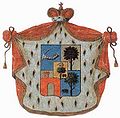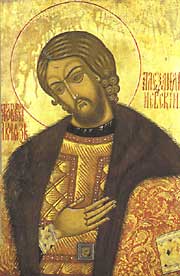Rurik Dynasty
The Rurik Dynasty or Rurikids (Rurikid Dynasty) were the ruling dynasty of Kievan Rus' (after 862), the successor principalities of Galicia-Volhynia (after 1199), Chernigov, Vladimir-Suzdal, and the Grand Duchy of Moscow, as well as the early Tsardom of Russia (after 1168).
According to the Primary Chronicle, the dynasty was established in 862 by Rurik, the legendary great ruler of Novgorod. The exact origin of his tribe, the Varangians ('Varyag') called Rus', is disputed and his ethnicity remains unclear, although Scandinavian and Slavic influences are cited, and by charting the Y chromosome of his modern agnatic descendants the genetic origin of his patriline has been shown to have likely been tshuudi (Finno-Ugric) (see "Rurikid Dynasty DNA Project", below). He and his brothers founded a state that later historians called Kievan Rus'. By the middle of the twelfth century, Kievan Rus' had dissolved into independent principalities (Russian, or Rus' principalities), each ruled by different branches of the Rurik dynasty.
In the west, Galicia-Volhynia continued to be ruled by the Rurikids until 1323. The last ones were two brothers Andrew and Lev II, who ruled jointly and were slain trying to repel Mongol incursions on behalf of the rest of Europe. Polish king Władysław I the Elbow-high in his letter to the Pope wrote with regret: "The two last Ruthenian kings, that had been firm shields for Poland from the Tatars, left this world and after their death Poland is directly under Tatar threat." Losing their leadership role, Rurikids, however, continued to play a vital role in the Grand Duchy of Lithuania and the later Polish-Lithuanian Commonwealth. Most notably, the Ostrogski family held the title of Grand Hetman of Lithuania and strove to preserve the Old Ukrainian language and Eastern Orthodoxy in this part of Europe.
In the north-east, the principality of Moscow won a struggle for supremacy among medieval Rus states by the end of the fifteenth century. Beginning with the reign of Ivan the Terrible, the Muscovite branch of the Rurik dynasty used the title "Tsar of All Russia" and ruled over the Tsardom of Russia. The death in 1598 of Tsar Feodor I ended the rule of the Rurik dynasty. The unstable period known as the Time of Troubles succeeded Feodor's death and lasted until 1613. In that year, Mikhail I ascended the throne, founding the Romanov dynasty that would rule until 1762 and as Holstein-Gottorp-Romanov until the revolutions of 1917. One descendant of the Rurik Grand Prince of Tver was Catherine the Great, who married Peter III of the Romanov dynasty. Historian Vasily Tatishchev and filmmaker Jacques Tati were descended from Rurik.
 Gagarin family / Khilkoff Coat of Arms |
 The Obolensky - Repnin coat of arms is composed of the emblems of Kiev and Chernigov. |
 Coat of arms of the Gorchakov family |
 Ostrogski Coat of Arms |
Among Rurik descendants are the Volkonsky, Obolensky, Shuyski, Dolgorukov, Khilkoff, Repnin, Gorchakov, Gagarin, Wassilchikov, and Putyatin families, as well as the Ruthenian families of Ostrogski, Wareg-Massalski, and Czetwertyński families, among others.
Contrary to some early-modern Polish genealogical concoctions, neither Rurik nor St.Vladimir the Great were direct agnatic forefathers of the Gediminid dynasty. Rurikid Project Instead, Gediminas was genetically a remote collateral agnatic kinsman of Rurik, coming also from a Finnic genetical patriline.
Gediminids like Rurikids, are another genetically Finnic-origin dynasty with an Y DNA belonging to the N1C1 haplogroup. Gediminas shares the same Y DNA haplogroup, which means Gediminas has a common agnatic forefather ('proto-Tshuudi') with the Rurikids in the distant past, around two millennia ago. This project's results demontrate false the early-modern Polish genealogical concoction which made Gediminas a direct male-line descendant of St.Vladimir of Kiev (the concocted pedigree had the lineage passing via Rogneda's son Iziaslav of Polatsk).
Further genetic studies seem to indicate the existence of two major haplogroups among modern Rurikids: the descendants of Vladimir II Monomakh (Monomakhoviches) and some others are of N1c1 group (130 people or 68%), while the descendants of a junior prince from the branch of Oleg I of Chernigov (Olgoviches) and some others (total 45 peoples or 24%) are of R1a and R1b haplogroups typical for Slavic, Germanic and Celts peoples.
Contents |
List of rulers of the Rurik Dynasty
The following image shows the descent of the so-called central branch of the Rurikids, descendants of Vladimir II Monomakh through his sixth son Yuri Dolgorukiy:

Princely families of Rurik stock
from princes of
- Starodub: Gagarin , Golibesovsky, Gundorov, Kovrov, Krivoborsky, Lyalovsky, Nebogaty, Neuchkin, Ossipovsky, Paletsky, Pozharsky, Romodanovsky, Ryapolovsky, Tatev, Tulupov and Khilkoff.
- Polotsk: Vitebsky, Izyaslavsky, Drutsky, Minsky and Polotsky.
- Peremyshl: Galitsky and Peremyshlsky.
- Chernigov: Baryatinsky , Belevsky , Volkonsky , Vorotynsky , Gorensky , Gorchakov , Dolgorukov , Yeletsky , Zvenigorodsky-Ryumin , Zvenigorodsky-Barashev , Zvenigorodsky-Spyachy , Zvenigorodsky-Shestov , Zvenigorodsky-Zventsov , Zvenigorodsky-Tokmakov , Zvenigorodsky-Nozdrevaty , Karachevsky, Kashin , Klubkov-Massalski, Kozelsky, Koltsov-Massalski , Koninsky, Kurlyatev , Litvinv-Massalski , Lykov , Massalski, Massalsky, Machevsky, Mezetsky, Obolensky, Nogtev-Obolensky, Strigin-Obolensky, Yaroslavov-Obolensky, Nagiye-Obolensky, Telepnev-Obolensky, Ovchinin-Telepnev-Obolensky, Obolensky-Cherny, Obolensky-Bely, Obolensky-Zoloty, Obolensky-Serebryany, Odoevsky, Ogiński, Ossovitsky, Peremyshlsky (Peremyshl of Kaluga), Peninsky, Puzyny, Repnin, Repnin-Volkonsky , Svyatopolk-Chetvertinsky , Spashsky, Torussky, Trostensky , Turenin, Tufyakin , Khotetovsky , Shchepin-Obolensky and Shcherbatov .
- Ryazan: Muromsky and Pronsky.
- Galich (Southern Galich): Babichev , Bakrinovsky, Volynsky, Drutsky, Drutsky-Ozeretsky, Drutsky-Sokolinsky, Drutsky-Gorsky, Drutsky-Lyubetsky , Drutsky-Podberezhsky, Zaslavsky, Lutsky, Ostrogski, Skajnowski and Putyatin.
- Smolensk: Vyazemsky, Berezuisky, Dashkov, Zhizhemsky, Kozlovsky, Korkodinov, Kropotkin, Porkhovsky, Rzhevsky, Selekhovsky, Solomeretsky and Fominsky.
- Yaroslavl: Alabyshev, Alenkin, Belsky, Velikogagin, Golygin, Dulov, Deyev, Zhirovy-Zasekin, Zaozersky, Zasekin, Zubaty, Kubensky, Kurbsky, L'vov, Molozhsky, Mortkin, Okhlyabinin, Penkov, Prozorovsky, Sandyrevsky, Siseev, Sitsky, Sontsov, Sontsov-Zasekin, Sudsky, Temnosiny, Troekurov, Ukhorsky, Ushaty, Skulimowski, Khvorostinin, Yukhotsky, Shamin, Shastunov, Shakhovskoy, Shekhonsky, Shumorovsky and Shchetinin.
- Rostov: Bakhteyarov-Rostovsky, Brity-Rostovsky, Buinosov-Rostovsky, Bychkov-Rostovsky, Gvozdev-Rostovsky, Golenitsin-Rostovsky, Goluby-Rostovsky, Kasatkin-Rostovsky, Katyrev-Rostovsky, Lastkin-Rostovsky, Lobanov-Rostovsky, Priimkov-Rostovsky, Puzhbolsky-Rostovsky, Temkin-Rostovsky, Khokholkov-Rostovsky, Shchepin-Rostovsky and Yanov-Rostovsky.
- Beloozero: Andomsky, Beloselsky, Vadbolsky, Dyabrinsky, Kargolomsky, Kemsky, Sugorsky, Ukhtomsky and Sheleshpansky.
- Suzdal: Barbashin, Brukhaty-Shuisky, Glazaty-Shuisky, Gorbaty-Shuisky, Kirdyapin-Shuisky, Nizhegorodsky, Nogtev-Suzdalsky, Skopin-Shuisky and Shuisky.
- Moscow: Borovsky, Vereisky, Volotsky, Galitsky (Galich of Merya), Mozhaisky, Uglitsky and Shemyakin.
- Tver: Dorogobuzhsky, Kashinsky, Mikulinsky, Telyatevsky , Kholmsky and Chernyatinsky.
Noble families of Rurik stock
who do not use or lost their princely titles, from princes of
- Chernigov: Satin.
- Smolensk: Aladyin, Bezsonov, Bokeev, Burukhin, Vnukov, Vsevolozhsky, Gubastov, Danilov, Dmitriev, Dmitriev-Mamonov, Dobrynsky, Yeropkin, Zabolotsky, Ivanov, Karpov-Dalmatov, Kisleevsky, Knutov, Korobyin, Molody, Monastyrev, Mussorgsky, Netshin, Polev, Rezanov, Rzhevsky, Rozhestvensky, Sapogov, Solomin, Sudakov, Tatishchev, Tolbuzin, Travin, Tsyplyatev and Shukalovsky.
- Galich (Galich of Merya): Berezin, Ivin, Ilyin, Lyapunov, Ossinin.
- Belozersk:Belosselsky-Belozersky Kurtsov, Funikov.
- Ryazan: Ovtsyn, Lykov, Zhulyebin, Bulgakov, Denysyev, Nazarov, Izmailov, Zamyatin, Zlobin, Velyaminov, Fedorov.
- Rostov: Krasnov.
- Tver: Agryenev.
See also
- Rulers of Kievan Rus’
- Shum Gora
- Vikings, Scandinavians of whom some travelled eastwards and southwards
- Grand Prince of Tver
- Knyaz
External links
- Genealogy of the Rurik dynasty from Genealogy.eu
- Family Tree DNA's Rurik Dynasty DNA Project
- Genealogical chart of Dukes of Kiev
|
|||||||||
|
|||||||||||||||||||||||||||||||||||||||||||||||||||||||||||||||||||||||||||||||||||||||||||||||||||||||||||||||||||||||

.jpg)